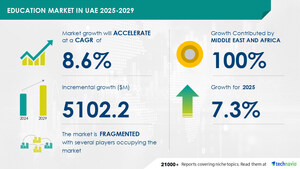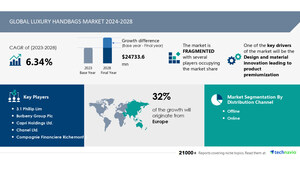NEW YORK, May 27, 2024 /PRNewswire/ -- The global fast food market size is estimated to grow by USD 123.43 billion from 2023-2027, according to Technavio. The market is estimated to grow at a CAGR of 3.28% during the forecast period.
For more insights on the forecast market size and historic data (2017 - 2021) - Request a sample report!
Fast Food Market Scope |
|
Report Coverage |
Details |
Base year |
2022 |
Historic period |
2017 - 2021 |
Forecast period |
2023-2027 |
Growth momentum & CAGR |
Accelerate at a CAGR of 3.28% |
Market growth 2023-2027 |
USD 123.43 billion |
Market structure |
Fragmented |
YoY growth 2022-2023 (%) |
2.6 |
Regional analysis |
North America, APAC, Europe, South America, and Middle East and Africa |
Performing market contribution |
APAC at 34% |
Key countries |
US, China, Japan, Germany, and UK |
Key companies profiled |
American Dairy Queen Corp., Chipotle Mexican Grill Inc., Corporativo Bimbo SA de CV, Dominos Pizza Inc., Doughnut Time Ltd., Focus Brands LLC, Glory Hole Doughnuts, Inspire Brands Inc., JAB Holding Co. Sarl, Jack in the Box Inc., Jimmy Johns Franchisor SPV LLC, McDonald Corp., Papa Johns International Inc., Penn Station Inc., Pita Pit Ltd., Restaurant Brands International Inc., Starbucks Corp., The Subway Group, The Wendys Co., and YUM Brands Inc. |
Market Driver
The fast food market in the US experienced growth in 2022, with an increase of 1,183 outlets, reaching a total of 197,163 outlets. Urbanization and a larger white-collar population fueled this expansion. Diverse consumer preferences for various food types, such as baked goods and hot beverages, also contributed.
The emergence of food carts, online ordering, and digital platforms further shaped the market. Urbanization led to an increase in convenience foods, on-the-go snacks, and meal kits. Supply-chain disruptions and labor restraints posed challenges, while healthy food options, protein choices, and international cuisines emerged as trends.
Market Challenges
• The fast food market is characterized by trends such as food carts, online ordering, and consumer preferences for convenience and urbanization. Supply-chain disruptions and labor restraints influence business models, including cloud kitchens and fast-casual restaurants. Consumers spend on various food offerings, including snacking habits, seafood, burgers, and protein options.
• Urban populations favor Mexican food and international cuisines, while franchises and restaurants expand their menus with meal kits and ready-to-eat meals. Chronic diseases like obesity and diabetes are concerns due to junk food consumption, leading to increased demand for healthy alternatives. Keywords: consumer spending, digital platforms, urbanization, convenience foods, on-the-go snacks, labor restraints, cloud kitchen business, meal kits, ready-to-eat meals, chronic diseases.
Research report provides comprehensive data on impact of trend, driver and challenges - Request a sample report!
Segment Overview
- Product
- 1.1 Non-vegetarian fast food
- 1.2 Vegetarian fast food
- Geography
- 2.1 North America
- 2.2 APAC
- 2.3 Europe
- 2.4 South America
- 2.5 Middle East and Africa
1.1 Non-vegetarian fast food- In the dynamic fast food market, product segmentation plays a pivotal role in catering to diverse consumer preferences. Food carts and online ordering platforms have gained traction, allowing consumers to access a wide range of non-vegetarian offerings from the comfort of their homes or on-the-go. Urbanization and digital platforms have fueled the demand for fast-food franchises, restaurants, and meal kits, particularly among millennial consumers with disposable income. Consumer spending on snacking habits, seafood, burgers, and protein options has driven the growth of the market.
The fast-casual restaurant sector, with its focus on healthy foods and innovative sandwich toppings, has emerged as a significant player. International cuisines, such as Mexican food and Chinese food, have also gained popularity. Supply-chain disruptions and labor restraints have necessitated the rise of cloud kitchen businesses and distribution networks.
The trend towards convenient, ready-to-eat meals and on-the-go snacks has been further accentuated by lockdown restrictions and the shift towards full-service restaurants offering pick-up orders and food delivery services. Consumer spending on junk food consumption, despite the rise of chronic diseases, remains robust. The market for burgers & sandwiches, pizzas & pasta, and fried chicken continues to expand, driven by consumer preferences and the franchise business model. The Hispanic population's growing influence on food trends, particularly in Mexican food, is another key factor shaping the market's growth.
For more information on market segmentation with geographical analysis including forecast (2023-2027) and historic data (2017-2021) - Download a Sample Report
Research Analysis
In the current landscape, the fast food market is experiencing significant shifts due to various factors. Convenience foods and on-the-go snacks have gained popularity amidst lockdown restrictions, leading to an increase in pick-up orders and food delivery services. Labor restraints have forced many full-service restaurants to adapt, with meal kits and cloud kitchen businesses emerging as viable alternatives.
Urbanization and digital platforms have further fueled this trend, enabling consumers to order from fast food franchises, coffee shops, fast food outlets, food carts, and more, all from the comfort of their homes. Consumer spending on healthy foods has also risen, indicating a shift towards balanced diets even within the fast food sector.
Market Research Overview
In the rapidly evolving food industry, the fast food market continues to be a significant player, offering convenience and affordability to consumers worldwide. These businesses specialize in preparing and serving meals with a quick turnaround time, utilizing a standardized menu and efficient production processes. The fast food market caters to diverse tastes and dietary preferences, with offerings ranging from burgers and fries to salads and vegetarian options.
The industry's success is driven by factors such as affordability, accessibility, and the convenience of on-the-go dining. Furthermore, technological advancements have enabled the integration of digital ordering systems, contactless payment options, and delivery services, enhancing the overall customer experience. The fast food market's future looks promising, with continued innovation and expansion expected to meet the evolving demands of consumers.
Table of Contents:
1 Executive Summary
2 Market Landscape
3 Market Sizing
4 Historic Market Size
5 Five Forces Analysis
6 Market Segmentation
- Product
- Non-vegetarian Fast Food
- Vegetarian Fast Food
- Geography
- North America
- APAC
- Europe
- South America
- Middle East And Africa
7 Customer Landscape
8 Geographic Landscape
9 Drivers, Challenges, and Trends
10 Company Landscape
11 Company Analysis
12 Appendix
About Technavio
Technavio is a leading global technology research and advisory company. Their research and analysis focuses on emerging market trends and provides actionable insights to help businesses identify market opportunities and develop effective strategies to optimize their market positions.
With over 500 specialized analysts, Technavio's report library consists of more than 17,000 reports and counting, covering 800 technologies, spanning across 50 countries. Their client base consists of enterprises of all sizes, including more than 100 Fortune 500 companies. This growing client base relies on Technavio's comprehensive coverage, extensive research, and actionable market insights to identify opportunities in existing and potential markets and assess their competitive positions within changing market scenarios.
Contacts
Technavio Research
Jesse Maida
Media & Marketing Executive
US: +1 844 364 1100
UK: +44 203 893 3200
Email: [email protected]
Website: www.technavio.com/
SOURCE Technavio

WANT YOUR COMPANY'S NEWS FEATURED ON PRNEWSWIRE.COM?
Newsrooms &
Influencers
Digital Media
Outlets
Journalists
Opted In






Share this article